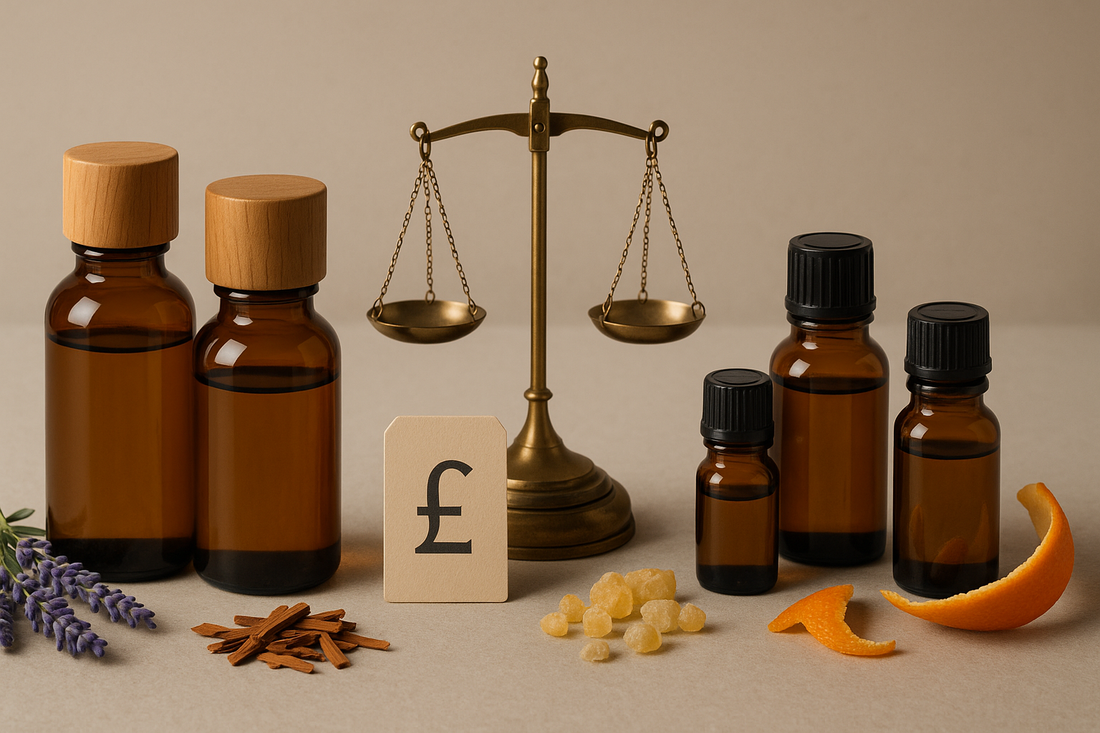
The Question of Price
What Should You Really Pay for Essential Oils?
Essential oils have exploded in popularity, promising everything from a calmer mind to a fresher home. But stroll through a high street shop or scroll online, and the prices can leave you very confused—one supplier sells a small bottle of lavender costing £3, while another charges £15.00. So, what should you really pay for essential oils?
The answer isn’t one-size-fits-all, but it hinges on quality, production, and trust. Here’s an expert insight into what drives the price and why choosing suppliers certified by the Aromatherapy Trade Council (ATC) can make all the difference.
The Price Puzzle?
Essential oils are not a standard manufactured consumer product, they are a product of nature and therefore they are more expensive than synthetic fragrances. For example, it might take 100 kilograms of flowers to produce just one litre of lavender oil. A comparison with citrus essential oils, squeezed from peels (a by-product of the juice industry) explains why lavender is more expensive. Rose, neroli and jasmine are particularly expensive because the yield is so low - It typically takes around 3,000 to 5,000 kilograms of fresh rose petals to produce just one litre of rose essential oil.
The yield impacting on cost can vary depending on factors such as the extraction method used and the specific variety of rose. Rarity is also relevant - for example sandalwood or frankincense, from slow-growing trees, can be very expensive because supply is limited.
Climate, soil, and even the country of origin effect price. (French lavender vs. English, say) impact on the oil’s chemistry and value. A drought, a poor harvest or global conflict and trade route blockages all disrupt yield and supply impacting on price.
Demand also affects price, for instance lavender and tea tree are exceptionally popular so there is a large global production and a competitive marketplace. Helichrysum however is a specialist oil with low demand, so supply is low, and the pricing is not so competitive.
Growing conditions matter too. Essential oils produced from organically grown plants, free of pesticides, cost more to cultivate. Also, the extraction of organic oils is more expensive because chemical extraction which increases yield cannot be used.
Finally, there’s the supply chain. Distribution, shipping, and packaging are increasingly expensive.
Why are some essential oils offered at unbelievably low prices?
An essential oil at a very low price should be treated with caution. The low price is often achieved by “cutting or stretching.” Inexpensive essential oils can be stretched (the yield artificially increased) with synthetic fillers or low-cost base oils, and therefore, they lack therapeutic value.
One warning sign is the absence of the botanical/Latin name on the label. Examining the “inci” list can also help identify oils that have been “cut” and therefore have little or no therapeutic value.
Another reason for a low price is potentially that the oil is “nature identical” and not a true essential oil.
Nature identical essential oil fragrances are synthetic scents that replicate the aroma of natural essential oils using natural chemical components, often sourced from cheaper materials. While they may smell similar to authentic oils, they lack the therapeutic properties and are produced for budget products e.g. cleaning or laundry and not for therapeutic application.
Safety risk of ultra inexpensive oils
Low-quality, aging, impure and “cut” oils usually sold cheaply potentially expose the user to toxins and allergens, which are a risk to health and they are unlikely to have any therapeutic value.
What’s a “Fair” Price Range for a true therapeutic grade essential oil?
For a 10ml bottle of quality of pure therapeutic quality essential oil, here’s what you might expect to pay, based on industry norms:
- Mainstream Oils: Lavender, tea tree, or peppermint—£5 to £15. These are widely grown and straightforward to extract.
- Citrus Oils: Lemon, orange, or grapefruit—£4 to £10. Abundant peels keep costs down.
- Florals: Rose, jasmine, or neroli—£30 to £100+. Petal-heavy and labour-intensive.
- Woody Oils: Sandalwood, cedarwood, or frankincense—£20 to £50. Slow-growing trees mean higher prices.
- Organic Versions: Add £5-£20 to any of these for certified organic oils.
These are ballpark figures for pure, undiluted oils from reputable suppliers. If you are paying very low prices then proceed with caution, as you may not be buying a genuine oil with therapeutic properties that will benefit your health. ATC suppliers may not be the cheapest in the market because they invest in quality control, ethical sourcing, and compliance, which inexpensive brands cannot match.
How ATC-Certified Suppliers assure quality, safety and efficacy of the essential oils that you purchase from them
Suppliers registered with the Aromatherapy Trade Council (ATC) adhere to strict standards to ensure the quality, safety, and proper labelling of their oils, complying with UK and international product safety laws. ATC member pricing is transparent, guaranteeing genuine oils that meet the ATC’s Code of Practice. ATC oils are tested, traced, and listed with batch numbers and origins, ensuring high-quality therapeutic oils from sustainable and fair trade sources. Many suppliers also offer certified organic options.
What can you expect when you buy from an ATC supplier?
When buying from ATC-certified suppliers, you can expect to see the botanical (Latin) name on the label, which verifies the plant source. Additionally, you can request GC-MS testing results and the Material Safety Data Sheet (MSDS), which provide transparency regarding the oil's quality, composition, and safety. Information about the country of origin, the part of the plant used (such as leaf, flower, twig, peel, or root), and the extraction method is also available, further confirming the oil's purity and provenance.


